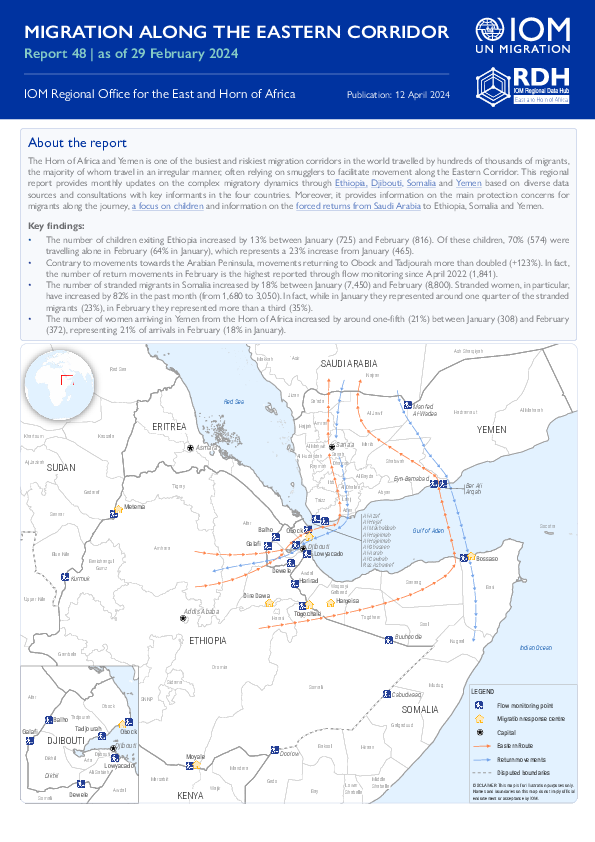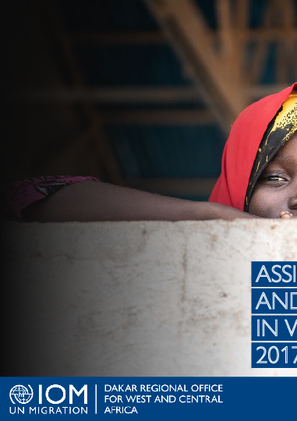-
Countries
-
Data and Analysis
-
Special Focus
-
Crisis Responses
Flow Monitoring
Domain host
migration.iom.int
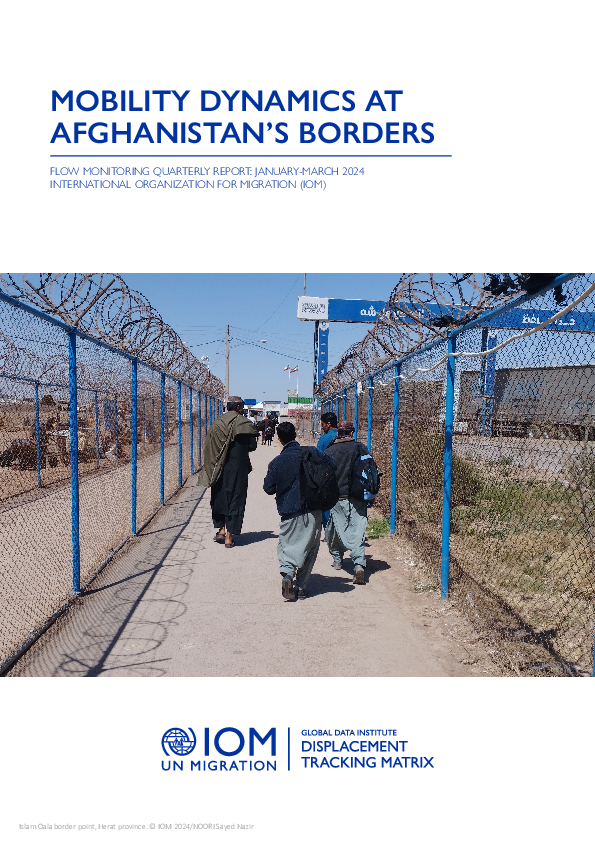
Contact
DTMAfghanistan@iom.int
Language
English
Location
Afghanistan
Period Covered
Jan 10 2024
Mar 31 2024
Activity
- Survey
- Flow Monitoring Survey
- Flow Monitoring
Over the course of decades marked by conflict, Afghanistan has experienced significant movement across its borders with neighboring countries the Islamic Republic of Iran and Pakistan. This movement, influenced by linguistic, geographical, and economic factors, has played a crucial role in shaping regional dynamics and fostering cultural ties between these countries. With 4.5 million Afghan nationals currently living in the Islamic Republic of Iran and 3.2 million currently living in Pakistan1, Afghan nationals not only seek economic opportunities, international protection and safety in these countries, but often visit family or participate in short-term travel for health and other reasons. In late 2023, policies and statements by officials in both the Islamic Republic of Iran and Pakistan called for the expulsion of undocumented foreigners, the majority of whom are Afghan nationals. Developments such as these recent policies targeting Afghan migrants have impacted movements to Afghanistan, as seen late last year when returns from Pakistan increased following the announcement of the “Illegal Foreigners’ Repatriation Plan (IFRP),” setting a deadline for unregistered or undocumented foreigners to voluntarily return to their countries or face deportation.
In response to these recent movements, IOM Afghanistan re-launched its DTM Flow Monitoring (FM) activity at the beginning of 2024 to provide critical insights into current mobility dynamics at Afghanistan’s borders. Flow Monitoring is designed to track the scale and characteristics of human mobility along the borders, including volume, intended destinations, reasons for movement, and intended lengths of stay. From January to the end of March 2024, DTM counted 567,411 individuals entering Afghanistan, 406,919 leaving Afghanistan, and interviewed 49,441 regarding their reasons for movement and intentions. The following report provides findings from DTM’s Flow Monitoring exercises for the first three months of data collection, examining trends and profiles among inflow and outflow groups to inform better targeted response mechanisms.
The report is structured in four sections. The first section, “Cumulative Flow Trends,” gives an overview of the total inflow and outflow numbers and trends between January and March. This section is linked to DTM’s Flow Monitoring Counting exercise (see details in “Methodology and Limitations”). The second and third sections, “Mobility Dynamics: The Islamic Republic of Iran” and “Mobility Dynamics: Pakistan” explore findings from interviews with people leaving and entering Afghanistan via borders with the Islamic Republic of Iran and with Pakistan, respectively. These sections are followed by “Mobility Dynamics: Conclusions” which summarizes and analyzes the findings from the interviews. These last three sections are linked to DTM’s Flow Monitoring Surveys exercise (see details in “Methodology and Limitations”).

Contact
DTM Haiti, dtmhaiti@iom.int
Language
French
Location
Haiti
Period Covered
Mar 08 2024
Apr 09 2024
Activity
- Survey
- Flow Monitoring Survey
- Flow Monitoring
Since end of February 2024, the security situation has deteriorated in the Metropolitan Area of Port-Au-Prince (MAPAP), the capital of Haiti. In addition to creating displacement within the MAPAP, generalized insecurity are pushing more and more people to leave the capital to find refuge in provinces, taking the risks of passing through gangs-controlled routes. In order to monitor these movements towards provinces and inform appropriate response strategies, DTM has launched data collection at several of the most used bus stations in the capital (see page 5 for more details on the methodology). In one month of implementation of this activity (since 8 March), movements of 94,821 people leaving the MAPAP have been observed (see pages 3 and 4 for more details on their profile). The majority of them (58%) took means of transport heading towards the Grand Sud departments (Grande’Anse, South, Nippes and South-East). It should be noted that this region already hosts more than 116,000 people who had in vast majority, fled the MAPAP in recent months (see the report on displacement in the Grand Sud). Half of flows headed towards 3 main destination municipalities: Jérémie (in Grande’Anse), Les Cayes (South) and Léogâne (West).
It should be emphasized that provinces do not have sufficient infrastructures and host communities do not have sufficient resources that can enable them to cope with these massive displacement flows coming from the capital.
It should be noted that at the beginning of March, when the security situation worsened, people who were already internally displaced (IDPs) were the first to begin leaving the capital. Over time, more and more people who were not IDPs are also leaving: as of 10 March, 86% of people leaving the MAPAP were IDPs. One month later, this percentage dropped to 60%, while almost 40% were those who had never fled their residence and who decide to leave it and seek refuge in provinces. This further describes the deterioration of the situation in the capital, given that leaving the capital could be a relatively quicker decision to make for a person who was already displaced than for someone who was still in their residence and decides to leave it for seek refuge in provinces.
• The number of children exiting Ethiopia increased by 13% between January (725) and February (816). Of these children, 70% (574) were
travelling alone in February (64% in January), which represents a 23% increase from January (465).
• Contrary to movements towards the Arabian Peninsula, movements returning to Obock and Tadjourah more than doubled (+123%). In fact,
the number of return movements in February is the highest reported through flow monitoring since April 2022 (1,841).
• The number of stranded migrants in Somalia increased by 18% between January (7,450) and February (8,800). Stranded women, in particular, have increased by 82% in the past month (from 1,680 to 3,050). In fact, while in January they represented around one quarter of the stranded migrants (23%), in February they represented more than a third (35%).
• The number of women arriving in Yemen from the Horn of Africa increased by around one-fifth (21%) between January (308) and February
(372), representing 21% of arrivals in February (18% in January).

Contact
DTMCostaRica@iom.int
Language
English
Location
Costa Rica
Period Covered
Mar 01 2024
Mar 31 2024
Activity
- Flow Monitoring
- Mobility Tracking
- Event Tracking
Cantons: Alajuela, Alajuelita, Cartago, Desamparados, Escazú, Corredores, Heredia, Los Chiles, San Carlos, San José, Santa Ana, Santo Domingo, Tibás
Costa Rica, like the other countries in the Central American region, has been characterized as a migratory corridor for people who transit by land from the south to the north of America and whose destination is the countries in the north of the continent. This flow on the move through the Americas is mainly made up of people from the Bolivarian Republic of Venezuela, Cuba, Haiti, Ecuador, as well as people from other countries in South America, Africa and Asia.
According to estimations from IOM Costa Rica, during March 36,106 people entered the country, an approximate average of 1,165 people per day and estimating a decrease of 13% compared to February 2024. In addition, 1,178 people stranded in the monitored shelters were identified and 872 people stranded in the public places visited.
This document presents an analysis of interviews conducted with all individuals assisted in their voluntary return by the International Organization for Migration (IOM) between 2017 and 2023 to one of the 23 countries covered by the West and Central Africa region (WCA). The analysis combines datasets from both Assisted Voluntary Return and Reintegration (AVRR) and Voluntary Humanitarian returns (VHR).
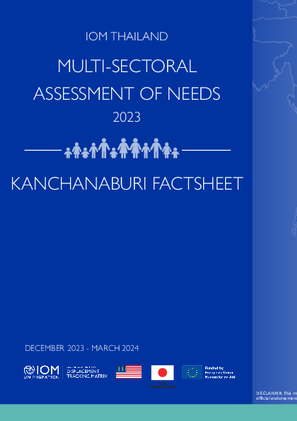
Contact
DTMThailand@iom.int
Language
English
Location
Thailand
Period Covered
Dec 29 2023
Mar 15 2024
Activity
- Survey
- Site Assessment
This factsheet aims to provide a snapshot of multi-sectoral conditions, needs, and challenges among Myanmar migrants in Kanchanaburi province as captured between December 2023 and March 2024 by IOM Thailand’s multi-sectoral assessment of needs. The purpose of this assessment is to provide insights regarding the severity of needs among migrant populations, identify vulnerable population groups and geographic areas with the most acute needs, inform assistance planning and relevant Sustainable Development Goals (SDGs) targets, and provide sectoral and inter-sectoral baselines for future assessments.
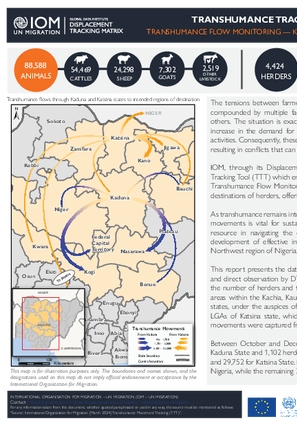
Contact
DTM Nigeria, iomnigeriadtm@iom.int
Language
English
Location
Nigeria
Period Covered
Oct 01 2023
Dec 31 2023
Activity
- Survey
- Flow Monitoring
This report presents the data collected between October and December 2023, through direct interviews and direct observation by DTM enumerators and triangulated via a network of key informants. It highlights the number of herders and their herds identified at 45 counting points. Between October and December 2023, the Transhumance Flow Monitoring tool identified 3,322 herders in Kaduna State and 1,102 herders in Katsina State. The animal count was estimated at 58,836 for Kaduna State and 29,752 for Katsina State. Notably, 80 per cent of the total number of herders departed from states within Nigeria, while the remaining 20 per cent departed from Niger.
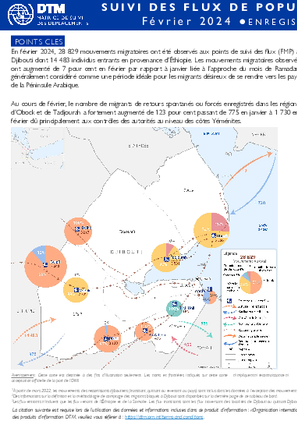
Contact
DTM Djibouti, DTMDjibouti@iom.int
Language
English
Location
Djibouti
Period Covered
Feb 01 2024
Feb 29 2024
Activity
- Flow Monitoring
En février 2024, 28 829 mouvements migratoires ont été observés aux points de suivi des flux (FMP) à Djibouti dont 14 483 individus entrants en provenance d’Éthiopie. Les mouvements migratoires observés ont augmenté de 7 pour cent en février par rapport à janvier liée à l’approche du mois de Ramadan généralement considéré comme une période idéale pour les migrants désireux de se rendre vers les pays
de la Péninsule Arabique.
Au cours de février, le nombre de migrants de retours spontanés ou forcés enregistrés dans les régions d’Obock et de Tadjourah a fortement augmenté de 123 pour cent passant de 775 en janvier à 1 730 en février dû principalement aux contrôles des autorités au niveau des côtes Yéménites.

Contact
DTM Djibouti, DTMDjibouti@iom.int
Language
English
Location
Djibouti
Period Covered
Feb 01 2024
Feb 29 2024
Activity
- Flow Monitoring
In February 2024, 28,829 migratory movements were observed at Djibouti's Flow Monitoring Points (FMPs), including 14,483 incoming individuals from Ethiopia. The observed migratory movements increased by 7 per cent in February compared with January, linked to the approach of the month of Ramadan, generally considered to be an ideal time for migrants wishing to travel to the countries in the Arabian
Peninsula.
During February, the number of spontaneous or forced return migrants recorded in the Obock and Tadjourah regions rose sharply by 123 per cent, from 775 in January to 1,730 in February, mainly due to checks by the authorities on the Yemeni coast.
Contact
DTMAFGHANISTAN@iom.int
Location
Afghanistan
Activity
- Flow Monitoring Survey
Period Covered
Jan 10 2024 -Jun 29 2024
IOM Afghanistan's DTM Flow Monitoring activity, initiated at the beginning of 2024, seeks to quantify and better understand the mobility dynamics at Afghanistan’s borders. On 10 January 2024, DTM began deploying field teams at four border crossing points with the Islamic Republic of Iran (IRN) and Pakistan (PAK), expanding to another border crossing point Ghulam Khan as of 11 February for a headcount of all individuals entering or leaving Afghanistan (including returnees), also called Flow Monitoring Counting (FMC), to gauge flow volume.
Population Groups
Migrants Present
Survey Methodology
Unit of Analysis Or Observation
Other
Type of Survey or Assessment
Keywords
Geographical Scope Partial Coverage
Administrative boundaries with available data
The current dataset covers the following administrative boundaries
Pagination
- Previous page
- Page 17
- Next page
